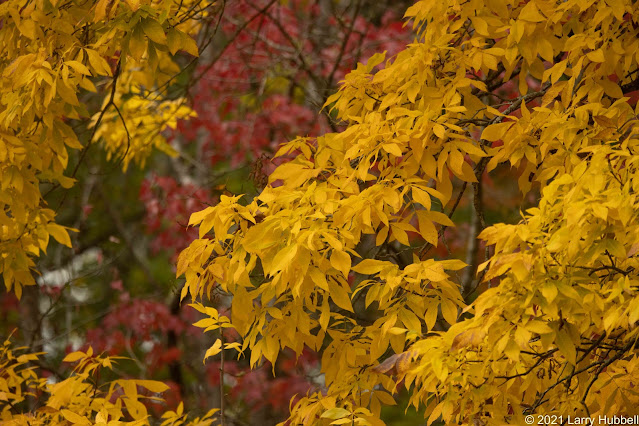Here is a recent post from the Union Bay Watch Blog published by Larry Hubbell, long-time local photographer and birder.
A Frugivore Test
The Fall provides an ephemeral beauty. One moment the leaves are bursting with color and the next they are on the ground, turning brown, replenishing the soil and providing food, shelter, and warmth for a variety of small creatures. Leaves tend to follow a fairly fast path around the circle of life.
Their similarly-sized cousins, the Varied Thrush, tend to raise their young in forested areas. In the Spring, while American Robins may be searching for worms in Western Washington cities, Varied Thrush are more likely to be found in the forests of the Olympic or Cascade Mountains, looking through the leaf litter for insects.
Fruits and nuts also fall from trees but they have the potential for much longer lives. I find it mind-numbing to wonder how many times a seed molecule might become part of a new tree, and then be transferred again into a new seed and then into another tree, and so on. Surely, the odds are slim for this process to be repeated infinitely, but it seems technically possible.
However, the seeds in most fruit do not become trees. Often when the fruit is consumed by other species, the seeds do not land in a fortuitous location, and the fruit molecules involved take a much shorter ride along the swifter side of the circle of life.
This post focuses primarily on some of our local fruit-eating birds. Not only do they help enable the life cycles of fruit trees, but their own lives, and life cycles, are also enabled by the fruit they consume.
In this post, your challenge is to determine which of the six bird species shown are frugivores.
Note: For our purposes, any birds that eat fruit are frugivores. It does not matter if they are part-time fruit eaters - since fruit is seasonal this is the most likely situation.
All six species have been photographed near fruit in the last month.
Some are common birds.
Some are not seen so often.
Of the species shown above, three belong to the Thrush (Turdidae) family, two are Warblers (Dendroica) and one is a Waxwing (Bombycilla). All are winter residents in our area. (For the advanced birders a secondary challenge is, Which of these species does not breed locally?)
In the same order they were presented the six species are:
1. Varied Thrush
2. Townsend's Warbler
3. Cedar Waxwing
4. American Robin (also a Thrush)
5. Hermit Thrush and
6. Yellow-rumped Warbler
To be totally open and consistent it is the foods listed for each species in All About Birds that have been used to objectively determine whether we consider them frugivores.
Your primary challenge is to determine from memory which of these species are not known to eat fruit. You should make your mental list before proceeding.
*******************
Spoiler Alert!
The following photos will show many of these species eat fruit.
*******************
In the Spring, you will often see them sporadically sprinting across lawns, sometimes stopping to listen, and then snagging, stretching, and securing worms, to take to their young.
In the Fall, some of them come to the cities. However, they are bashful. When you find a fruit tree full of feeding Robins look closely at the birds on the far side of the tree, sometimes, you may see a Varied Thrush.
It is obvious they are attracted to the fruit, but how they decide when and where to feed is a mystery to me. Unlike the Robins, they are not likely to feed until the fruit is gone. On the whole, they feed more briefly, return less frequently, and flock more tightly.
Of the three Thrush mentioned the Hermit Thrush, true to its name, is the least likely to be seen. It is also the smallest in size and roughly three times smaller in weight. Visually, they are closer in size to Song Sparrows than to the other two Thrush. However, their shape is clearly quite similar to their larger cousins.
Their size has a logical impact on where they can be seen. Since Thrush prefer to eat fruit whole they tend to be found feeding in trees with the smallest of fruit.
Curiously, Cedar Waxwings are similar in weight to the Hermit Thrush, but they appear to be able to eat larger fruit. Their bills seem longer and apparently able to open wider. They may be just better adapted as frugivores.
The last frugivore in our group may be the most surprising of all, the Yellow-rumped Warbler. By weight, they are about half the size of the average Hermit Thrush. (On the other hand, they can be as much as fifty percent larger than the Townsend's Warblers - which is the only other winter Warbler found in Western Washington.)
















No comments:
Post a Comment